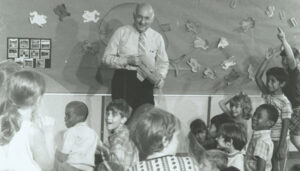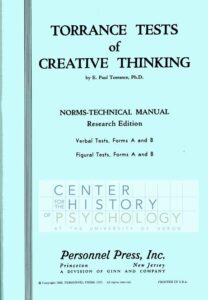Paul Torrance — A Much Revered Thought Leader in the Field of Creativity

Paul Torrance is one of the most respected thinkers in the field of creativity. He mentored my first mentor, Dr. Mary Murdock, who I first met at the Center for Applied Imagination at Buffalo State University. He is perhaps best known for the “Torrance Incubation Model” of creativity. It has three components:
Step 1: Heighten Anticipation – get the student’s attention, ignite curiosity and inspire motivation to learn
Step 2: Deepen Expectations – lead students to create meaningful learning
Step 3: Extend the Learning – give students fuel for incubation to carry the learning far beyond the lesson
Torrance was great at creating inventory lists essential for creative thought. For example …
Torrance’s Creativity Skill Set
The Problem: recognition or awareness of a situation; definition of the problem and commitment to deal with it; recognizing the essence of the difficulty and identifying sub problems that are manageable or can be solved.
Be Original: moving away from the obvious; breaking away from habit bound thinking; statistically infrequent responses; the ability to create novel, different or unusual perspectives.
Be Flexible: creating variety in content; producing different categories; changing one’s mental set to do something differently; perceiving a problem from different perspectives.
Produce and Consider Many Alternatives: fluency; amount; generating many and varied ideas.
Be Aware of Emotions: recognizing verbal and nonverbal cues; responding, trusting and using feelings to better understand people and situations.
Elaborate-But Not Excessively: adding details or ideas–developing them; filling in details for possible implementation.
Combine and Synthesize: making new connections with the elements within our perceptual set; combining relatively unrelated elements; hitchhiking; making the familiar strange and the strange familiar.
Highlight the Essence: identifying what is most important and absolutely essential; discarding erroneous or relevant information; refining are dealers, abandoning unpromising information; allowing a single problem or idea to become dominant and synthesizing all of this at the same time.
Put Your Ideas in Context: putting parts of experience into a bigger framework; putting experiences together in a meaningful way; making connection between things; giving situations and ideas a history, and background, a story.
Keep Open: resisting premature closure; resisting the tension to complete things in the easiest, quickest way.
Visualize It-Richly and Colorfully: using vivid, exciting imagery; creating colorful and exciting images that appeal to all five senses.
Make It Swing! Make It Ring: using kinesthetic and auditory senses; responding to sound and movement.
Look at It Another Way: being able to see things from a different visual perspective; being able to see things from a different psychological perspective or mindset.
Enjoy and Use Fantasy: imagine, play and consider things that are not concrete or do not yet exist.
Visualize the Inside: paying attention to the internal dynamic workings of things; picturing or describing the inside of things.
Breakthrough-Expand the Boundaries: thinking outside prescribed requirements; changing the paradigm or system within which a problem resides.
Let Humor Flow and Use It: perceiving incongruity; responding to a surprise; recognizing and responding to perceptual and conceptual discrepancies.
Get Glimpses of the Future: predict, imagine and explore things that do not yet exist; wonder and dream about possibilities; view events as open-ended.
*****************************************
But perhaps my favorite is Torrance’s Manifesto for Children”. Maybe because it is so inspirational and motivational —
1. Don’t be afraid to fall in love with something and pursue it with intensity.
2. Know, understand, take pride in, practice, develop, exploit, and enjoy your greatest strengths.
3. Learn to free yourself from the expectations of others and walk away from the games they impose on you. Free
yourself to play your own game.
4. Find a great teacher or mentor who will help you.
5. Don’t waste energy trying to be well-rounded.
6. Do what you love and can do well.
7. Learn the skills of interdependence.
Dr. Paul Torrance is someone everyone who is passionate about creativity should know.
